
The City and Borough of Yakutat is a borough in the U.S. state of Alaska and was the name of a former city within it. The name is Tlingit, Yaakwdáat but it originally derives from an Eyak name diyaʼqudaʼt and was influenced by the Tlingit word yaakw. The borough covers an area about six times the size of the U.S. state of Rhode Island, making it one of the largest counties in the United States. As of the 2010 census, the population was 662, down from 680 in 2000.

Angoon is a city on Admiralty Island in Hoonah-Angoon Census Area, Alaska, United States. At the 2000 census the population was 572; by the 2010 census the population had declined to 459. The name in Tlingit, Aangóon, means roughly "isthmus town."
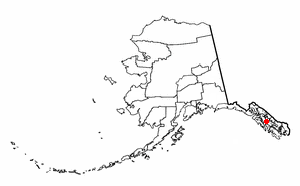
Kake is a first-class city in Prince of Wales-Hyder Census Area, Alaska, United States. The population was 557 at the 2010 census. The name comes from the Tlingit word Ḵéix̱ or Ḵéex̱, which is derived from ḵée 'dawn, daylight' and x̱ʼé 'mouth', i.e. 'mouth of dawn' or 'opening of daylight'.

The City and Borough of Wrangell is a borough in the Alaska, United States. As of the 2010 census the population was 2,369, up from 2,308 in 2000. Incorporated as a Unified Home Rule Borough on May 30, 2008, Wrangell was previously a city in the Wrangell-Petersburg Census Area. Its Tlingit name is Ḵaachx̱aana.áakʼw. The Tlingit people residing in the Wrangell area, who were there centuries before Europeans, call themselves the Shtaxʼhéen Ḵwáan after the nearby Stikine River. Alternately they use the autonym Shxʼát Ḵwáan, where the meaning of shxʼát is unknown.
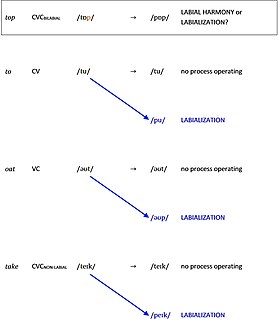
Labialization is a secondary articulatory feature of sounds in some languages. Labialized sounds involve the lips while the remainder of the oral cavity produces another sound. The term is normally restricted to consonants. When vowels involve the lips, they are called rounded.
In phonetics, ejective consonants are usually voiceless consonants that are pronounced with a glottalic egressive airstream. In the phonology of a particular language, ejectives may contrast with aspirated, voiced and tenuis consonants. Some languages have glottalized sonorants with creaky voice that pattern with ejectives phonologically, and other languages have ejectives that pattern with implosives, which has led to phonologists positing a phonological class of glottalic consonants, which includes ejectives.

Na-Dene is a family of Native American languages that includes at least the Athabaskan languages, Eyak, and Tlingit languages. An old inclusion of Haida is now considered doubtful.
The Tlingit language is spoken by the Tlingit people of Southeast Alaska and Western Canada. It is a branch of the Na-Dene language family. Extensive effort is being put into revitalization programs in Southeast Alaska to revive and preserve the Tlingit language and culture.

The Battle of Sitka (1804) was the last major armed conflict between Russians and Alaska Natives, and was initiated in response to the destruction of a Russian trading post two years before. The primary combatant groups were the Kiks.ádi Clan of Sheetʼká Xʼáatʼi of the Tlingit nation and agents of the Russian-American Company assisted by the Imperial Russian Navy.
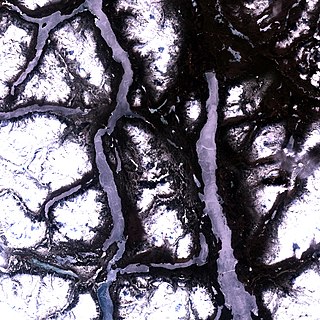
Atlin Lake is the largest natural lake in the Canadian province of British Columbia. The northern tip of the lake is in Yukon, as is Little Atlin Lake. However, most of the lake lies within the Atlin District of British Columbia. Atlin Lake is believed to be the source of the Yukon River although it is drained via the short Atlin River into Tagish Lake.
The Teslin Tlingit Council (TTC) is a First Nation band government in the central Yukon in Canada, located in Teslin, Yukon along the Alaska Highway and Teslin Lake. The language originally spoken by the Teslin Tlingit or Deisleen Ḵwáan is Tlingit. Together with the Taku River Tlingit or Áa Tlein Ḵwáan around Atlin Lake of the Taku River Tlingit First Nation in British Columbia, they comprise the Inland Tlingit.
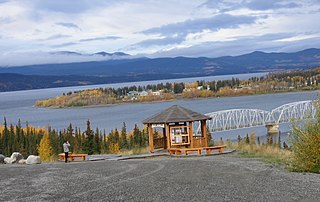
The community of Teslin includes the Village of Teslin in Yukon, Canada. Teslin is situated at historical Mile 804 on the Alaska Highway along Teslin Lake. The Hudson's Bay Company established a small trading post at Teslin in 1903. In the 2011 census, the population of the village was 122, a decrease of 13.5% from the 2006 census, and that of the reserve was 138, a decrease of 11.5% from 2006.

Nora Marks Dauenhauer was a Tlingit poet, short-story writer, and Tlingit language scholar from Alaska. She won an American Book Award for Russians in Tlingit America: The Battles of Sitka, 1802 And 1804.

Richard Dauenhauer was an American poet, linguist, and translator who married into, and subsequently became an expert on, the Tlingit nation of southeastern Alaska. He was married to the Tlingit poet and scholar Nora Marks Dauenhauer. With his wife and Lydia T. Black, he won an American Book Award for Russians in Tlingit America: The Battles of Sitka, 1802 And 1804

The culture of the Tlingit, an Indigenous people from Alaska, British Columbia, and the Yukon, is multifaceted, a characteristic of Northwest Coast peoples with access to easily exploited rich resources. In Tlingit culture a heavy emphasis is placed upon family and kinship, and on a rich tradition of oratory. Wealth and economic power are important indicators of status, but so is generosity and proper behavior, all signs of "good breeding" and ties to aristocracy. Art and spirituality are incorporated in nearly all areas of Tlingit culture, with even everyday objects such as spoons and storage boxes decorated and imbued with spiritual power and historical associations.

The history of the Tlingit involves both pre-contact and post-contact historical events and stories. The traditional history involved creation stories, the Raven Cycle and other tangentially related events during the mythic age when spirits freely transformed from animal to human and back, and the migration story of coming to Tlingit lands, clan histories. More recent tales describe events near the time of the first contact with Europeans. At that point, European and American historical records come into play, and though modern Tlingits have access to and review these historical records, they continue to maintain their own historical record by telling stories of ancestors and events important to them against the background of the changing world.

New Russia was a maritime fur trading post and penal colony established by Russians in 1796 in what is now Yakutat Borough, Alaska. It was presumably named after the Joseph Billings ship Slava Rossii, or "Glory of Russia". The post was attacked and destroyed by Tlingits in 1805. It consisted of 7 buildings inside a stockade, and 5 buildings outside. The buildings were burnt in 1805, and the site was never again occupied. The events at New Russia represent a pivotal moment in Russian-Tlingit relations. As an archaeological site, it was declared a National Historic Landmark in 1978.
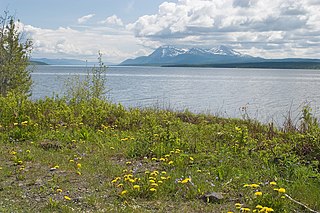
Teslin Lake is a large lake spanning the border between British Columbia and Yukon, Canada. It is one of a group of large lakes in the region of far northwestern BC, east of the upper Alaska Panhandle, which are the southern extremity of the basin of the Yukon River, and which are known in Yukon as "the Southern Lakes". The lake is fed and drained primarily by the Teslin River, south and north, but is also fed from the east by the Jennings River and the Swift River, and from the west by the Hayes River.













